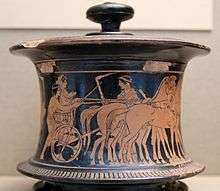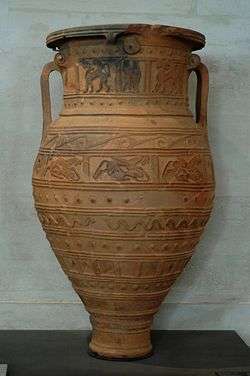Pandora's box

Pandora's box is an artifact in Greek mythology, taken from the myth of Pandora's creation in Hesiod's Works and Days.[1] The "box" was actually a large jar (πίθος pithos)[2] given to Pandora (Πανδώρα, "all-gifted, all-giving"),[3] which contained all the evils of the world. Pandora opened the jar and all the evils flew out, leaving only "Hope" inside once she had closed it again.
Today the phrase "to open Pandora's box" means to perform an action that may seem small or innocent, but that turns out to have severely detrimental and far-reaching negative consequences. The action cannot be reversed.
In mythology
In classical Greek mythology, Pandora was the first woman on Earth. Zeus ordered Hephaestus to create her. So he did, using water and earth.[4] The gods endowed her with many gifts: Athena clothed her, Aphrodite gave her beauty, Apollo gave her musical ability, and Hermes gave her speech.[5]
According to Hesiod, when Prometheus stole fire from heaven, Zeus took vengeance by presenting Pandora to Prometheus' brother Epimetheus. Pandora opens a jar containing death and many other evils which were released into the world. She hastened to close the container, but the whole contents had escaped except for one thing that lay at the bottom – Elpis (usually translated "Hope", though it could also mean "Expectation").[6]
Etymology of the "box"

The original Greek word was 'pithos', which is a large jar, sometimes as large as a small person (Diogenes of Sinope was said to have slept in one). It was used for storage of wine, oil, grain or other provisions, or, ritually, as a container for a human body for burying.[7][8] In the case of Pandora, this jar may have been made of clay for use as storage as in the usual sense, or of metal, such as bronze, as an unbreakable prison.[9]
The mistranslation of pithos is usually attributed to the 16th century humanist Erasmus of Rotterdam who translated Hesiod's tale of Pandora into Latin. Erasmus rendered pithos as the Greek pyxis, meaning "box".[10] The phrase "Pandora's box" has endured ever since. This misconception was further reinforced by Dante Gabriel Rossetti's painting Pandora.
Pandora in art
See also Category:Pandora at Wikimedia Commons.
-

Rosetti's Pandora (1879)
-

Waterhouse's, Pandora, 1896)
-

Jean Alaux, Pandora carried off by Mercury, 18th or 19th century
-

Political cartoon by James Gillray, employing the image of Pandora.
See also
Notes
- ↑ Hesiod, Works and Days 47ff..
- ↑ Hesiod, Works and Days 94.
- ↑ Evelyn-White, note to Hesiod, Works and Days 81.; Schlegel and Weinfield, "Introduction to Hesiod" p. 6; Meagher, p. 148; Samuel Tobias Lachs, "The Pandora-Eve Motif in Rabbinic Literature", The Harvard Theological Review, Vol. 67, No. 3 (Jul., 1974), pp. 341-345.
- ↑ Hesiod, Works and Days 61–64.
- ↑ Hesiod, Works and Days 62–82.
- ↑ Hesiod, Works and Days 83–108; Gantz, pp 156–157.
- ↑ Cf. Harrison, Jane Ellen, Prolegomena to the Study of Greek history, Chapter II, The Pithoigia, pp.42-43. Cf. also Figure 7 which shows an ancient Greek pot painting in the University of Jena where Hermes is presiding over a body in a pithos buried in the ground. "In the vase painting in fig.7 from a lekythos in the University Museum of Jena we see a Pithoigia of quite other and solemn booty. A large pithos is sunk deep into the ground. It has served as a grave. ... The vase-painting in fig. 7 must not be regarded as an actual conscious representation of the rupent rite performed on the first day of the Anthesteria. It is more general in content; it is in fact simply a representation of ideas familiar to every Greek, that the pithos was a grave-jar, that from such grave-jars souls escaped and to them necessarily returned, and that Hermes was Psychopompos, Evoker and Revoker of souls. The vase-painting is in fact only another form of the scene so often represented on Athenian white lekythoi, in which the souls flutter round the grave-stele. The grave-jar is but the earlier form of sepulture; the little winged figures, the Keres, are identical in both classes of vase-painting."
- ↑ Cf. Verdenius, p.64
- ↑ Cf. Jenifer Neils, in The Girl in the Pithos: Hesiod’s Elpis, in "Periklean Athens and its Legacy, Problems and Perspectives", p.41 especially. "Many scholars wish to see a close analogy between Pandora herself, made from clay, and the clay pithos which dispenses evils, and they have even identified the girl in the jar as Pandora. They ignore, however, Hesiod's description of Pandora's pithos as arrektoisi or unbreakable. This adjective, which is usually applied to objects of metal, such as gold fetters and hobbles in Homer (Il. 13.37, 15.20), would strongly imply that the jar is made of metal rather than earthenware, which is obviously capable of being broken."
- ↑ Meagher, p. 56. In his notes to Hesiod's Works and Days (p.168) M.L. West has surmised that Erasmus may have confused the story of Pandora with the story found elsewhere of a box which was opened by Psyche.
References
- Athanassakis, Apostolos, Hesiod: Theogony, Works and Days and The Shield of Heracles. Translation, introduction and commentary, Johns Hopkins University Press, Baltimore and London, 1983. Cf. P.90
- Gantz, Timothy, Early Greek Myth: A Guide to Literary and Artistic Sources, Johns Hopkins University Press, 1996, Two volumes: ISBN 978-0-8018-5360-9 (Vol. 1), ISBN 978-0-8018-5362-3 (Vol. 2).
- Hesiod; Works and Days, in The Homeric Hymns and Homerica with an English Translation by Hugh G. Evelyn-White, Cambridge, MA.,Harvard University Press; London, William Heinemann Ltd. 1914. Online version at the Perseus Digital Library.
- Lamberton, Robert, Hesiod, New Haven: Yale University Press, 1988. ISBN 0-300-04068-7. Cf. Chapter II, "The Theogony", and Chapter III, "The Works and Days", especially pp. 96–103 for a side-by-side comparison and analysis of the Pandora story.
- Meagher, Robert E.; The Meaning of Helen: in Search of an Ancient Icon, Bolchazy-Carducci Publishers, 1995. ISBN 978-0-86516-510-6.
- Neils, Jenifer, "The Girl in the Pithos: Hesiod’s Elpis", in Periklean Athens and its Legacy. Problems and Perspective, eds. J. M. Barringer and J. M. Hurwit (Austin: University of Texas Press), 2005, pp. 37–45.
- Revard, Stella P., "Milton and Myth" in Reassembling Truth: Twenty-first-century Milton, edited by Charles W. Durham, Kristin A. Pruitt, Susquehanna University Press, 2003. ISBN 9781575910628.
- Rose, Herbert Jennings, A Handbook of Greek Literature; From Homer to the Age of Lucian, London, Methuen & Co., Ltd., 1934. Cf. especially Chapter III, Hesiod and the Hesiodic Schools, p. 61
- Schlegel, Catherine and Henry Weinfield, "Introduction to Hesiod" in Hesiod / Theogony and Works and Days, University of Michigan Press, 2006. ISBN 978-0-472-06932-3.
- Verdenius, Willem Jacob, A Commentary on Hesiod Works and Days vv 1-382 (Leiden: E.J. Brill, 1985). ISBN 90-04-07465-1. This work has a very in-depth discussion and synthesis of the various theories and speculations about the Pandora story and the jar. Cf. p. 62 & 63 and onwards.
